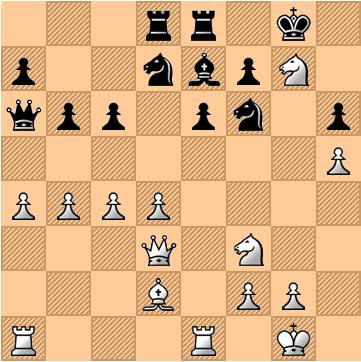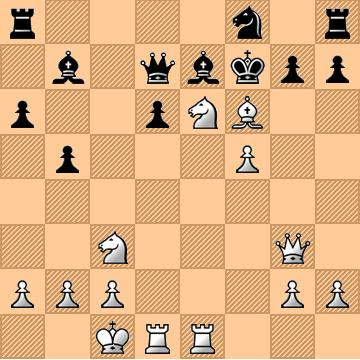Cleveland US-Open 1957
Sicilian Defense: Dragon Variation, Yugoslav Attack
1. e4, c5
2. Nf3, d6
3. d4, cxd4
4. Nxd4, Nf6
5. Nc3, g6
6. Be3, Nc6
7. f3, Bg7
8. Qd2, 0-0
9. Bc4 ....
The Yugoslav Attack of the Dragon Variation. This opening results in extremely tactical and decisive battles. White keeps a firm grip on the center while advancing aggressively towards the enemy king with f2-f4-f5 and even g2-g3-g4. However, danger exists in overextending and allowing Black to gain the initiative with a deadly counter-attack. Black's strategy is centered around the half-open c file and his ability to push the a and b pawns. Throughout the entire course of the battle, Black will be looking to break the center with an advance from d6-d5. Black can even sometimes obtain a winning endgame even after sacrificing the exchange, because of White's h-pawn sacrifice, doubled isolated c-pawns and most importantly the lack of mobility of the white Rooks compared to the Black minor pieces. (Source: Wikipedia)
9. .... a6
10. 0-0-0, Qc7
11. Bb3, b5
12. Nxc6, Qxc6
13. Nd5, Kh8
White threatens 14. Nxe7 double-check.
14. Nxf6!! ....
Far more powerful than 14. Nxe7 Qb7, 15. Nxc8 Raxc8, and Black gains control of the open c-file.
14. .... e6
Blocking 15. Bd5. Now, White has gained a piece!
15. Bh6, Bb7
16. Bxg7+, Kxg7
17. Ng4, f5
18. exf5, Rxf5
19. Qxd6, h5
20. Qe7+, Rf7
21. Qxf7, Kxf7
22. Ne5+, Ke7
23. Nxc6+, Bxc6
24. Rhe1, Bd7
25. Rxd7+, Resigns
With material and strategic advantage, White will ultimately capture Black's remaining pawns.



































